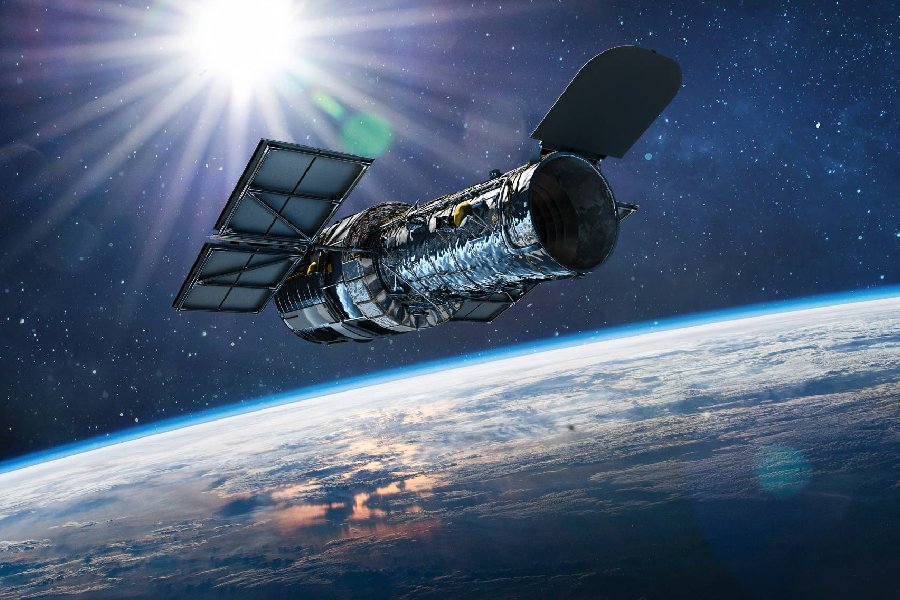For over 30 years, the Hubble Space Telescope has dazzled humanity with its glimpses of distant stars, galaxies, and cosmic wonders. But what exactly is this orbiting observatory that has revolutionized astronomy? What is the Hubble telescope?
In this beginner’s guide, we’ll learn all about Hubble – from its launch and instrumentation to some of its most mind-blowing discoveries. You’ll understand the cutting-edge technologies powering its deep space vision and the crucial role of space shuttle missions in maintaining operations.
From nebulae to black holes, Hubble showcased the most iconic images and helped us expand our understanding of the universe’s evolution.
By the article’s end, you’ll appreciate how this stellar orbital sentry continues pushing the frontiers of space science through remarkable insights into galaxies over 13 billion lightyears away!
What Is the Hubble Telescope?
What’s its definition, and why is the Hubble telescope important? The Hubble Space Telescope is a powerful astronomical observatory orbiting Earth, providing unprecedented views of the universe. Launched in 1990, it has revolutionized our understanding of space by capturing stunning images and collecting data in various wavelengths. This has enabled groundbreaking scientific discoveries.
Hubble’s observations have contributed to studies of distant galaxies, the expansion of the universe, and the formation of celestial bodies.
Its position above Earth’s atmosphere eliminates atmospheric distortions, allowing for sharper and clearer images than ground-based telescopes. The Hubble Space Telescope continues to be a crucial tool in advancing our knowledge of the cosmos and remains an iconic symbol of space exploration.

The Expanding Impact of Hubble on Science, Technology, and Culture
The Hubble Space Telescope provided humanity with unprecedented visual data, unlocking discoveries. Its deep space images enabled calculating cosmic expansion rates and detection of exoplanets.
Technologically, Hubble pioneered advanced mirror and instrument capabilities. Culturally, iconic pictures stirred global awe about space. Hubble inspired artistic interpretations through photos like the majestic Eagle Nebula pillars.
The famous Hubble Deep Field image, dense with uncountable galaxies, humbled perspectives about Earth’s scale and origins.
Across scientific models, engineering feats sustaining decades of orbital operation, and broadly shared images embedding space inspiration culturally – Hubble delivered multidimensional impacts, expanding conceptions of the cosmos.
What Sets Hubble Apart From Earth-Based Telescopes?
What does Hubble telescope do? The Hubble Space Telescope achieves scientific impacts exceeding earthbound observatories through orbital positioning, advanced optics, and specialized instruments. Hubble collects super clear cosmic data without any interference from the Earth’s atmosphere or sunlight.
Orbital path
Hubble orbits Earth at an altitude of 525 kilometers in low Earth orbit, completing one revolution approximately every 95 minutes. This stable orbiting allows Hubble to conduct scientific observations nearly 45% of the time as it circles Earth, maximizing productivity.
Its vantage point avoids interference from weather, daylight cycles, and atmospheric gasses that limit ground-based telescopes.
Unexpected discoveries
- Hubble provided unexpected findings like galaxy superwinds expelling interstellar matter
- Capturing early universe images exceeded pre-launch predictions
- Hubble helped recalculate expansion rate and age estimates for the cosmos
Essential components
- Hubble’s 13-ton spaceframe carries a 2.4-meter primary mirror for gathering light
- Five science instruments span cameras to spectrometers analyzing various phenomena
- Fine Guidance Sensors precisely lock onto targets
- Onboard computers control operations
- Solar arrays replenish power sources
Data transmission
- To relay observational data to Earth for study, Hubble transmits over 30 gigabits daily
- Directional high-gain antennas beam multiple data streams via microwave and radio frequencies
- NASA’s Deep Space Network receives and processes the complex trove of data
Role in operations
Hubble’s onboard computers automate monitoring, calibration adjustments, data handling, and equipment protection protocols. It also executes stored command sequences for repetitive tasks. This maximizes efficiency in nonlinear 24/7 space operations. Automation enables scientists to gather more data for research.
The Mission of Hubble Space Telescope
Mission origins
The Hubble Space Telescope aimed to enable groundbreaking deep-field observation capabilities exceeding terrestrial telescopes.
Launched in 1990, the Hubble observatory had objectives. These objectives spanned various areas, including studying interstellar medium composition and tracking galaxy evolution. Another objective was measuring velocities via redshift observations. Finally, the objectives involved probing origins back to nearly the Big Bang.
Discoveries and advancements
Over 30+ years in operation, Hubble made monumental discoveries. These discoveries included accurately determining the universe’s expansion rate. They also included capturing early galaxies forming after the Big Bang.
They included proving the existence of black holes. And detecting an abundance of extrasolar planets as another achievement. Additionally, Hubble unveiled the intricacies of planetary nebula structure through high-resolution imagery.
Hubble data supported the development of the revolutionary Lambda-Cold Dark Matter universal model and enhanced cosmic distance measurement accuracy.
Through prolific, high-impact revelations, Hubble advanced humanity’s comprehension. The revelations were about galaxy clusters, nebula configurations, star life cycles, and more.
Hubble fundamentally advanced humanity’s comprehension of cosmic origin and evolution. Ongoing sweeping surveys continue catalyzing transformational understanding.
Conclusion
What is the Hubble telescope? We hope learning the background of the Hubble Space Telescope has shed light on what this incredible orbiting achievement is all about – from its hardware specifications to pivotal discoveries fundamental to cosmology.
Most of all, Hubble’s iconic images inspire global awe for the wonders of the universe. This guide aimed to convey something. It aimed to convey that Hubble’s technologies represent the pinnacles of space innovation.
It also aimed to convey how the glimpse Hubble provides stirred emotion. The glimpse of 200 billion galaxies makes humanity feel humbly tiny. Yet that same glimpse also makes humanity feel intimately connected across the depths of space and time.
Hubble’s legacy will persist as it continues revealing cosmic glories while opening doors to grander cosmic perspectives that shift worldviews on Earth.
